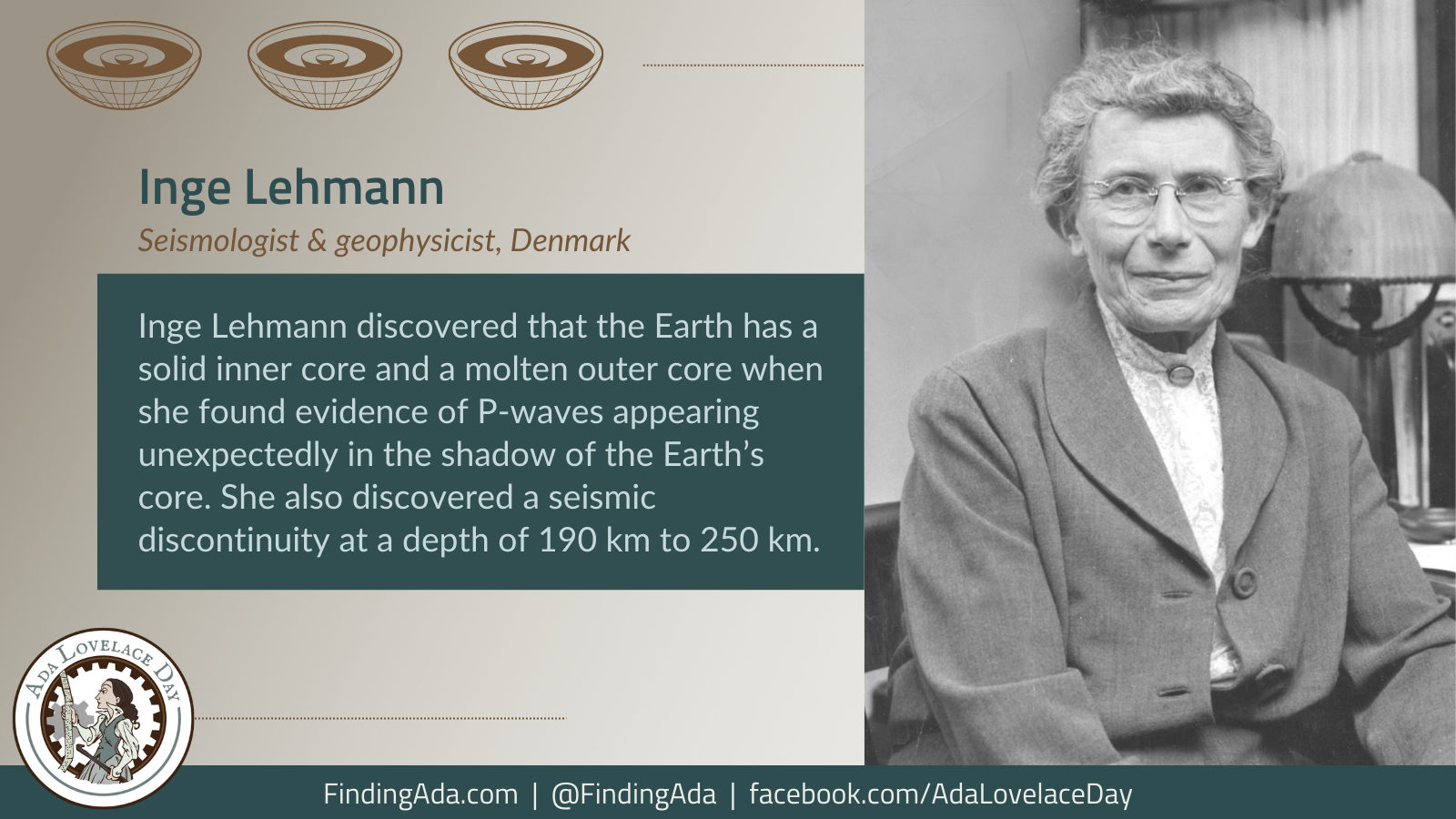
Inge Lehmann
Inge Lehmann was a seismologist and geophysicist who discovered that the Earth has a solid inner core and a molten outer core.
Born in Copenhagen in 1888, in 1907 she began studying mathematics, chemistry and physics at the University of Copenhagen and University of Cambridge, but had to take a break due to ill-health. She resumed her study of mathematics at Cambridge in 1910, before exhaustion enforced another break, eventually restarting her education at Copenhagen University in 1918, graduating in 1920.
Her interest in seismology began when she got a job as an assistant to Niels Erik Nørlund, a geodesist. She was tasked with setting up seismological observatories in Denmark and Greenland, which prompted her to study seismology. She earnt her magister scientiarum, equivalent to a master’s degree, in geodesy in 1928 and took a position as a geodesist and head of the department of seismology at the Geodetical Institute of Denmark. She was responsible for analysing the seismograph data, recording the seismic wave arrival times ready for publication in international bulletins. This data was fundamental to much of the era’s seismological research.
In 1936, she found evidence of P-waves appearing in the shadow of the Earth’s core, which she interpreted as showing that there was an inner core. At the time, it was thought that the Earth’s core was liquid, but an earthquake in New Zealand resulted in P-waves arriving at seismic stations that should have been blocked by this liquid core. Lehmann’s theory was that these P-waves had been refracted by some sort of boundary, which had to mean that there was a solid inner core and a liquid outer core.
Although this interpretation was adopted within a few years, it was not shown to be correct until 1971 when computer calculations using data from more sensitive seismographs could verify her work. Lehmann had to do all of her data collection and calculations by hand, creating boxes of cards, each with data from earthquakes around the world.
Although her work was interrupted by World War II, she served as Chair of the Danish Geophysical Society in both 1940 and 1944.
In the early 1950s, she moved to the US and began investigating the Earth’s crust and upper mantle. A decade later, she discovered a seismic discontinuity, where seismic waves change speeds, at between 190 and 250 km which is now known as the Lehmann Discontinuity. This discovery was made through “exacting scrutiny of seismic records by a master of a black art for which no amount of computerization is likely to be a complete substitute”, as geophysicist Francis Birch put it.
Lehmann received many awards over the years. She was elected as a Fellow of the Royal Society in 1969, was the first woman to win the William Bowie Medal in 1971, and was awarded the Medal of the Seismological Society of America in 1977. The American Geophysical Union began awarding the Inge Lehmann Medal to honour “outstanding contributions to the understanding of the structure, composition, and dynamics of the Earth’s mantle and core” in 1997. In 2015, the asteroid 5632 Ingelehmann was named after her, as was a new beetle species, Globicornis (Hadrotoma) ingelehmannae.
She died in 1993, aged 104.
Further Reading
- Inge Lehmann, Wikipedia
- Inge Lehmann: Discoverer of the Earth’s Inner Core, American Museum of Natural History
- Inge Lehmann, Meg Rosenburg, Trowelblazers, 16 October 2014
- How Inge Lehmann used earthquakes to discover the Earth’s inner core, Joseph Stromberg, Vox, 13 May 2015
- What Google’s doodle about Inge Lehmann is all about, Nick Statt, CNET, 13 May 2015
- Happy Birthday to Inge Lehmann, the Woman Who Discovered Earth’s Inner Core, Danny Lewis, Smithsonian Magazine, 13 May 2015
- The female scientist who discovered the core of the Earth, Lif Lund Jacobsen, Science Nordic, 15 May 2017
- Inge Lehmann: the Danish scientist who discovered Earth has a solid inner core, Brian Clegg, BBC Science Focus, 29 May 2020
- Inge Lehmann: Danish seismologist rocks Google’s earth, The Guardian, 13 May 2015